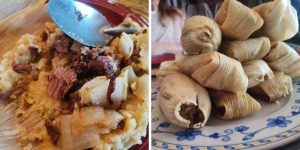Acorns are a staple of foraging. All oaks produce acorns, and all acorns are edible. But when it comes to learning how to eat acorns — especially processing them to remove the bitter tannins — there’s a bit of a trick to it. Processing acorns can be a bit of a chore, and beginners can sometimes meet with discouraging results. But never fear, wildcrafting enthusiasts. I’ve got a method for processing acorns that’s easy, simple, and fast. It’s time for the easiest . . . acorns . . . ever!
How to Eat Acorns: Basic Prep Work
The first thing we have to do is get the acorns out of their shell. This is true for any processing method. Remember that larger acorns are easier to work with and produce more food for the amount of effort you put in.
Normally, I use a hand-crank nut cracker. But my nut cracker is lost in a box somewhere and will likely stay lost until we finish remodeling the attic. In the meantime, I can make due with a handheld version and a pick. If you are using a handheld nutcracker, I recommend that you let your acorns dry out for a couple of weeks. They’ll be a lot easier to work with. If you have the rotary hand-crank kind, it really doesn’t matter.
More from the Homestead Guru: Fermented Sauerkraut: How to Make It + Other Tips(Opens in a new browser tab)
Once you have the nut meat out of its shell, I recommend grinding them up. Whole acorns can eventually be processed (usually), but crushed or ground acorns have more surface area to speed things along. (Hint: This is part of the secret to my super simple method regarding how to eat acorns).
If you come across acorns with bad spots, you can always cut those out. Or toss any that you’re not comfortable with. Don’t worry if you come across an acorn with a little worm in it. If you’re brave, they’re edible, too. They taste a little buttery.

Traditional Acorn Processing
Acorns contain chemicals called tannins that make them inedible without processing. (A few oaks are reputed to be so light on tannins that you can eat them raw. But I’ve never encountered them.) Traditional methods of removing the tannins come in “cold” and “hot” water versions.
The cold versions are fairly simple. You either place the shelled acorns in a bag and bury them at the bank of an active stream, or place them in a bowl of water and change it frequently. The upside to this is that it requires little skill and little effort, and it retains the acorns’ nutrition. The downside of this method is that it takes a really long time. Depending on the amount of tannins in your acorns, how frequently you change the water, and other factors, you could be waiting weeks or months. Some Indians reportedly came back a year later to dig up their acorns.
More from the Homestead Guru: Easy Organic Homemade Bread Recipe(Opens in a new browser tab)
The hot method involves boiling the acorns in multiple changes of water. This is faster, but can still take the better part of an afternoon. And here, too, we find some downsides. In a survival or wilderness setting, this method would require a lot of resources. You need a lot of fuel for your fire and several changes of water. There’s also some technique involved. You have to pour already-boiling water onto the acorns each time. If you pour cold water onto hot acorns, you risk binding the tannins to them, and they may never fully come out. Finally, this method cooks out the healthy oils from the acorns, rendering them less nutritious.
What’s a wildcrafter to do?
10-Minute Acorns
Things are about to get real easy around here.
This is the by far the easiest, fastest, and overall best method for processing acorns that I have ever come across.
Prepare to have your expectations blown out of the water by this super simple method.
Start by dumping your shelled acorns into a blender. Add water. The quantity isn’t really important. You just want the blender to be able to function. Now start your blender and let it go until the acorns are ground to a pulp. The longer you let it go, the better this will work. A minute or two is probably good. In a survival scenario, you could accomplish the same thing with a rock. But until then, a blender is much faster and easier.
Now pour the “acorn smoothie” into a cloth strainer bag. In a survival situation, you could use a clean sock. Now close the bag and hold it under running water in your sink. Massage the bag, allowing it to absorb water and then squeezing it back out. Do this until the water runoff is clear. Now squeeze out all the water you can, open the bag, and have a little pinch of the acorn meal. If it’s bitter, go back to massaging it under the water. Don’t be afraid to massage it a bit longer than you think it needs. Lingering tannins can throw the taste of your food off. The massaging process will probably take 3-7 minutes.
In a survival situation, you could do this in a stream or in a bowl, with a few changes of water.
Now you can wring out as much water as possible and spread out the acorn meal on a dehydrator or drying tray, or put it in your oven on warm, until it is completely dry. Because this process preserves more of the acorn oils, your acorn meal may have a tendency to spoil. Stick your dried acorn meal in the freezer to maximize its life. In a survival situation, you would ideally store the acorns in their shells and only process as many as you needed. Acorns can stay good all winter if kept in a cool, dry place.
Cooking With Acorns

Before I wrap up, let me give you a few example recipes that show you how to eat acorns. These are by no means the limits of what you can do with acorns, and a quick Google search will turn up several others for you.
But I’ll add in a little tip:
If you should find that you didn’t get all of those tannins out, and your recipe has some bitterness to it, try adding milk. Milk seems to bind with the tannins, making them fairly harmless.
If you’d like to see some more acorn recipes or to approach the traditional methods with a bit more finesse, you can read about that here.
More from the Homestead Guru: How to Cook With Acorns + 4 Recipes(Opens in a new browser tab)
Acorn Puddle-Cookies
This one has a story with it. The first time I tried this recipe, I used a standard cookie sheet without sides. What I didn’t know was that as the acorn meal got hot, it would run right off the sides of the sheet and land on the cooking element, setting the oven on fire. I did this two years in a row before I made a note in my recipe book. Let me save you the trouble. “Use a cookie sheet with sides.“
2 cups acorn flour
1 teaspoon baking soda
1 teaspoon cinnamon powder
1/8-1/4 teaspoon salt (to taste)
3 Tablespoons melted butter
1 egg
1 teaspoon vanilla extract
Add up to 1/4 cups water, if needed
Mix ingredients together, and pour the mixture onto a cookie sheet (with sides). You can arrange them like cookies, but I’ve never had them hold together. Maybe you’ll have better luck than me. Bake at 350°F (175°C) for 10 minutes. By the way, this isn’t my recipe, but I can’t remember where it came from. The original version wasn’t called a puddle-cookie.
Acorn Bread
1 cup acorn meal
1 cup white flour
1 egg
1 splash olive oil
1 teaspoon baking powder
1/4-1/2 cup sugar
Mix everything together, and cook it in the oven for 30 minutes at 400°F (200°C). Optionally, you can skip the sugar and pour maple syrup over the top when it comes out of the oven.
Simple Acorn Porridge
Just mix some acorn meal with water or milk (to desired thickness), and heat it up on the stovetop. Add sugar or maple syrup to taste. Nothing fancy, but it’s a warming breakfast for a cool fall morning. Yum.
Acorn Coffee
This one is a little different than the others, because it calls for unprocessed acorns. You grind up the acorns fairly fine in a coffee grinder. Then roast them on the stovetop. Remember to keep stirring them. You want them to brown, not burn. Boil the roasted grounds in water until it suits your tastes. It’s good with a little milk. Sadly, the grounds don’t seem to work in a coffee maker. They just soak up the first of the water and become an acorn gel. The rest of the water just runs around it. To have real success with acorn coffee, you’ll need to cook it over a stovetop or fire, and then strain the grounds out afterward.
Acorn coffee is one of the few coffee substitutes that I actually enjoy. It doesn’t contain any caffeine, and the taste makes me think of fall. I’m not sure what exactly is going on that keeps this from being a bitter, astringent mess. My guess is that the roasting process somehow locks the tannins into the acorn grounds, keeping them from leeching into the coffee. But, as I say, that’s just a guess.
More from the Homestead Guru: 12 Reasons Eating With Your Hands Will Improve Your Life(Opens in a new browser tab)
What Do You Think?
Have you had any experiences with acorns (good or bad)? Do you have an acorn recipe or advice on how to eat acorns that you’d like to share? Maybe you have an even better way to process acorns you’d like to tell us about. Share your comments and questions below!




